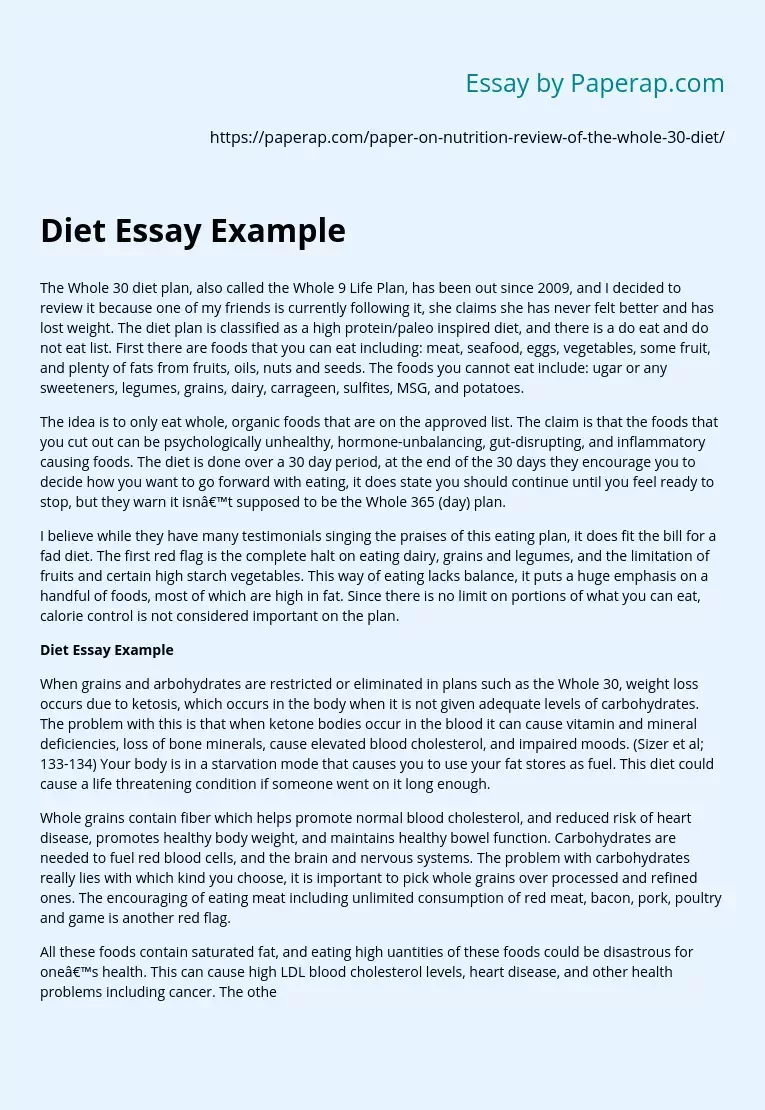Diet Essay Example
The Whole 30 diet plan, also called the Whole 9 Life Plan, has been out since 2009, and I decided to review it because one of my friends is currently following it, she claims she has never felt better and has lost weight. The diet plan is classified as a high protein/paleo inspired diet, and there is a do eat and do not eat list. First there are foods that you can eat including: meat, seafood, eggs, vegetables, some fruit, and plenty of fats from fruits, oils, nuts and seeds.
The foods you cannot eat include: ugar or any sweeteners, legumes, grains, dairy, carrageen, sulfites, MSG, and potatoes.
The idea is to only eat whole, organic foods that are on the approved list. The claim is that the foods that you cut out can be psychologically unhealthy, hormone-unbalancing, gut-disrupting, and inflammatory causing foods. The diet is done over a 30 day period, at the end of the 30 days they encourage you to decide how you want to go forward with eating, it does state you should continue until you feel ready to stop, but they warn it isn’t supposed to be the Whole 365 (day) plan.
I believe while they have many testimonials singing the praises of this eating plan, it does fit the bill for a fad diet. The first red flag is the complete halt on eating dairy, grains and legumes, and the limitation of fruits and certain high starch vegetables. This way of eating lacks balance, it puts a huge emphasis on a handful of foods, most of which are high in fat.
Since there is no limit on portions of what you can eat, calorie control is not considered important on the plan.
Diet Essay Example
When grains and arbohydrates are restricted or eliminated in plans such as the Whole 30, weight loss occurs due to ketosis, which occurs in the body when it is not given adequate levels of carbohydrates. The problem with this is that when ketone bodies occur in the blood it can cause vitamin and mineral deficiencies, loss of bone minerals, cause elevated blood cholesterol, and impaired moods. (Sizer et al; 133-134) Your body is in a starvation mode that causes you to use your fat stores as fuel. This diet could cause a life threatening condition if someone went on it long enough.
Whole grains contain fiber which helps promote normal blood cholesterol, and reduced risk of heart disease, promotes healthy body weight, and maintains healthy bowel function. Carbohydrates are needed to fuel red blood cells, and the brain and nervous systems. The problem with carbohydrates really lies with which kind you choose, it is important to pick whole grains over processed and refined ones. The encouraging of eating meat including unlimited consumption of red meat, bacon, pork, poultry and game is another red flag.
All these foods contain saturated fat, and eating high uantities of these foods could be disastrous for one’s health. This can cause high LDL blood cholesterol levels, heart disease, and other health problems including cancer. The other red flag for a fad diet is that it sounds too good to be true: cut out all these foods for 30 days and you lose weight and cure a list of health problems that run the gamut. It concerns me that on the message boards many parents are putting children on this diet in hopes of curing behavioral problems without consulting with a pediatrician or registered dietician.
While the Whole 30 plan does have some good points with cutting out processed foods and additives such as MSG, avocado, but overall it is too extreme to be a wholesome eating plan. The only proper and long lasting, healthy way to lose weight is by overall calorie control, eating a varied whole foods diet, and getting exercise. Sources: Sizer, Frances. Nutrition: concepts & controversies. 13th ed. Belmont, Calif. : Wadsworth Cengage Learning, 2013. Print. “The [email protected] Program. ” Whole9 Let us change your life. N. p. , n. d. Web. 10 Nov. 2013..
Diet Essay Example. (2019, Dec 05). Retrieved from https://paperap.com/paper-on-nutrition-review-of-the-whole-30-diet/

